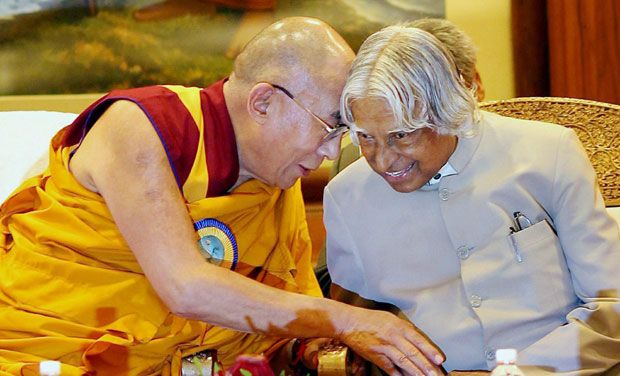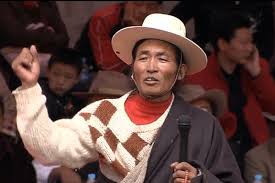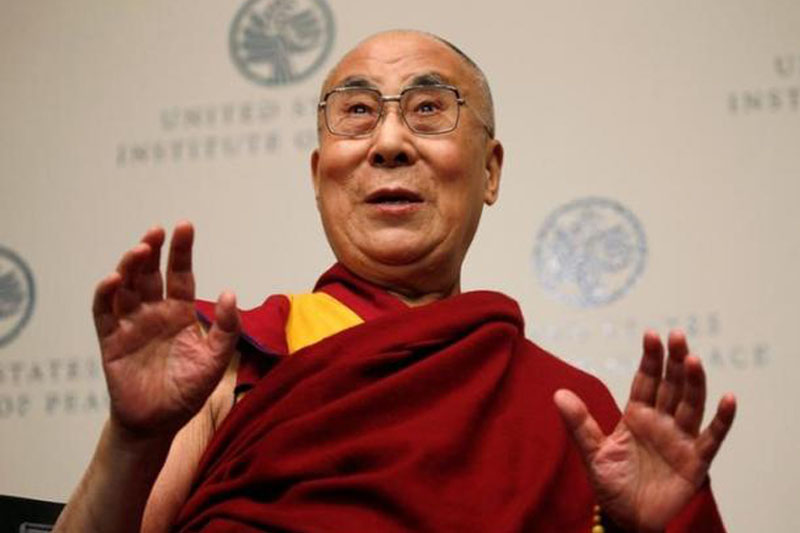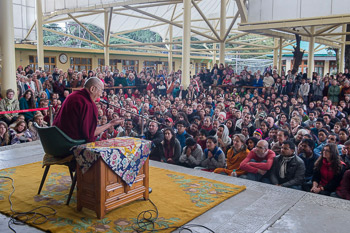Xi Jinping’s China now into the Reincarnation business ?
Claude Arpi, NitiCentral | July 27, 2015
The Communist leadership has recently developed a great knowledge about ‘soul’ reincarnation! Poor Karl Marx! Though probably he never heard about the possibility to ‘reincarnate’, he would have certainly disapproved and considered this a bourgeois revisionist ideological concept. But the times have changed.
This week, on the same day, China Tibet Online affiliated to Xinhua, published 5 articles on reincarnation of lamas, more particularly on the present Dalai Lama’s reincarnation.
One of the pieces explains that reincarnation is “a complete set of religious rites and historical mechanism” and “as China adopts the policy of freedom to religious belief,” the Communist Party accepts ‘reincarnations’. Of course, the recognition process must follow the Party’s rules and regulations, which prime over religious belief.
One of the articles goes into history and explains that the title of ‘Dalai Lama’ was conferred by the Central Government (China); it has a history of over 400 years, beginning in 1587 during the Ming Dynasty (1368-1644). The author conveniently forgets to mention the fact that ‘Dalai’ is a Mongol name meaning ‘Ocean’ (of Wisdom). But probably, Mongolia belonged to China too!
The article mentions ‘The Regulations on Religious Affairs’ and ‘Tibetan Buddhist Reincarnation Management Approach’ enacted in 2007 by the atheist Party in Beijing; it stipulated that “the Dalai Lama should follow the religious rites, historical mechanism and the national laws and regulations.”
Today, Beijing says that the present 14th Dalai Lama, living in India has
“No authoritative power on his [own] reincarnation issue”, it adds, quoting some of the Tibetan leader’s recent declarations, that the Tibetan leader even thought of appointing his own reincarnation while he was still alive, or reincarnating as a foreigner or a woman…”.
The article calls the Dalai Lama’s recent statements
“A blasphemy towards the religious rites and historical mechanism of Tibetan Buddhism, a great disrespect to the followers of the religion, and an absolute provocation towards the authority of the central government.”
Why this virulent campaign in favour of a reincarnation process ‘with socialist characteristics’ at this point in time?
Beijing is becoming increasing conscious that it is unable to control the restive populations living on the Tibetan Plateau and once the Dalai Lama departs for the Heavenly Fields, the situation may degenerate further. The Communist leadership wants to prepare the stage for a ‘safe’ Chinese Dalai Lama, under the Party’s control. It will help the Communist cause, they believe.
The present leader has repeatedly made it clear that the final decision about his future life(s) remains his own. Beijing however believes that it is the Party’s responsibility.
Another reason for urgency is the 50th anniversary of the Foundation of the Tibetan Autonomous Region which will be celebrated in 2015, as well as the Sixth Tibet Work Forum which will decide the policies for the Roof of the World for the next 5 or 10 years, which will be held in the coming weeks.
The Communist Government is banking on the Golden Urn process to turn the issue in its favour.
Though historically wrong, another article affirms:
“The procedure of drawing lots from the golden urn is the most significant religious rite and historic mechanism.”
Beijing’s tainted version of the history is that sometimes
“Several ‘soul boys’ appeared at the same time, it indubitably aroused disputes between different sides. To solve the problem, Emperor Qianlong granted two golden urns in 1792, one placed in the Lama Temple of Beijing and the other in the Jokhang Temple of Lhasa.”
The Golden Urn was indeed used a very few times in history, especially when Tibet was too weak to resist China’s bullying tactics (interestingly, Beijing admits today that the present Dalai Lama was ‘exempted’ of the test).
Now, Beijing would like to use the Golden Urn again for the next Dalai Lama, as they have done for their Panchen Lama candidate, Gyaltsen Norbu (for the past 20 years, the boy selected by the Dalai Lama is still languishing under house arrest somewhere in China).
How Norbu was selected is recounted by a Tibetan Lama, who participated in the ‘test’ and later managed to escape China.
The Lama, Arjia Rinpoche, the Abbot of the Kumbum monastery in today’s Qinghai Province, was part of the great tamasha to ‘select’ the 11th Panchen Lama in 1995.
The process is explained in his book, ‘Surviving the Dragon: A Tibetan Lama’s Account of 40 Years under Chinese Rule’.
In 1995, Beijing, furious that the Dalai Lama had ‘unilaterally’ decided on the new incarnation of the 10th Panchen Lama, decided to use the Golden Urn.
In November 1995, an emergency meeting was called in Beijing to ‘clarify’ the Communist Party’s position:
“We must not allow the Dalai’s separatist clique to interfere.”
To avoid the Dalai Lama being involved in the selection process, the Golden Urn was the best method, it was decided.
A few days later, some Party cadres and high Lamas were called to Lhasa.
As recalled by Arjia, the test was to be held in the Jokhang Cathedral:
“We landed at Gonggar airport in Lhasa, which was tightly guarded by People’s Liberation Army soldiers and armed policemen. …Soldiers were lined up along the entire route ‘for our protection’. …At the Lhasa Hotel, I saw squads of PLA soldiers with machine guns, as well as regular police, surrounding the hotel so that no one could slip in or out”.
The Communist officials told the rinpoches:
“The Golden Urn Ceremony will take place tonight, please be prepared. …If a separatist clique [followers of the Dalai Lama] attempts any disruption of the ceremony, everyone will be protected.”
The ceremony took place on November 29, 1995 at 2 am:
“As we walked toward the statue of the Buddha [the famous Jowo], we saw undercover policemen standing in every corner and shadow.”
Arjia Rinpoche continues the narration of the dramatic event:
“In front of the statue of Sakyamuni Buddha was a large table covered with a yellow silk cloth. Alone on the table stood a golden urn about 15 inches high, surrounded by seated high officials.”
Luo Gan, a Minister (later, a member of the Politburo’s Standing Committee) presided over the ceremony:
“Inside the gold urn was a small case, which contained three ivory lots, an inch wide and seven or eight inches long. The names of the three candidates were written on three separate pieces of paper, each of which was then slipped into a tightly fitted pouch of yellow silk. …The three ivory lots were placed into the Golden Urn.”
Arjia remembers:
“I expected him to lift the vessel and shake one of the lots out of the urn, but instead he passed his hand quickly over the lots and pulled one out.”
The name of the ‘selected’ candidate was Gyaltsen Norbu
An official present later told Arjia:
“When we made our selection we left nothing to chance. In the silk pouches of the ivory pieces we put a bit of cotton at the bottom of one of them, so it would be a little higher than the others and the right candidate would be chosen.”
That was it.
There is no doubt that the selection of the next Dalai Lama will be done in the same manner, if Beijing is allowed to have its way.
There is another factor that Beijing is aware of, though not mentioned in the recent articles.
Traditionally, the Panchen Lama has to put his seal on the entire process. To make sure that the Chinese protégé obeys, President Xi Jinping gave him an ‘audience’ at Zhongnanhai in Beijing on June 10. The encounter looked more like summons-cum-lecture than an ‘audience’. Xinhua announced that the meeting showed that the Party “has consistently given a high level of attention to Tibet.” It also indicated, said the news agency, “the great importance that the Central Committee attaches to the religious work.”
Apparently Gyaltsen Norbu, though selected by Beijing in a dubious manner, needed to be briefed: could he rebel like his predecessor and refuse to follow the diktats of the Party?
In all probability Norbu was told what he should do …in case of a new Dalai Lama needs to be ‘recognised’ by the Communist Party.
But, will this solve the Tibetan issue? Certainly not!
Disclaimer: Opinions expressed in this article are the author’s personal opinions. Information, facts or opinions shared by the Author do not reflect the views of Niti Central and Niti Central is not responsible or liable for the same. The Author is responsible for accuracy, completeness, suitability and validity of any information in this article.




